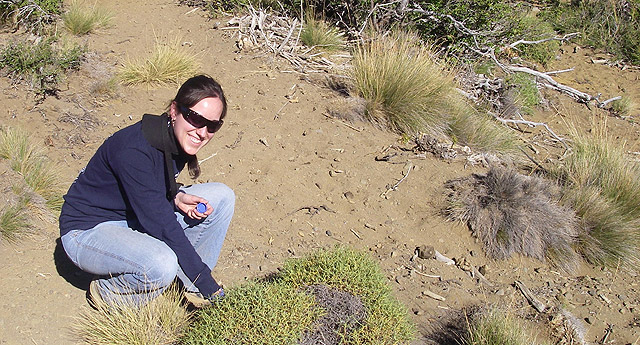Ph.D Candidate Kopac to Study Bacterial Evolution with NASA Award

Sarah Kopac, a Ph.D student in Professor of Biology Fred Cohan’s lab, has won a $20,000 NASA grant for research on ecological aspects of bacterial evolution in Death Valley National Park.
The grant, announced Jan. 11 by the Connecticut Space Grant College Consortium, will support Kopac’s study of Bacillus subtilis, a bacterium commonly found in soils that can endure extreme conditions, such as high heat levels.
Kopac, a third-year Ph.D candidate, is focused on identifying bacterial species that evolved within a gradient of salty soils – part of a broader effort to understand how ecological factors influence the spawning of new species.
NASA, the U.S. space agency, is eager to understand how life grows in Earth’s most extreme environments, as they may approximate conditions on other planets.
“Hypersaline environments may be analogs for Martian soils,” for example, Kopac says. “Microbes living in such environments could shed light on life which may have inhabited ancient Martian environments.”
Her current research focuses on an area of Death Valley, Lake Manly, where the salt content of the dry lakebed is extremely high. The first 100 meters west of the lakebed present a sharp salinity gradient, with stretches that contain soil bearing visible salt crystals as well as other stretches of nearly salt-free soil. The recent NASA grant will help pay the costs of gene sequencing, soil sampling and other aspects of her research.
“We’ll try to see if some bacteria seem to really like living in the high-salt soils,” she says.
Kopac is the latest student in Cohan’s lab to win an award from the consortium, which administers NASA money for science and engineering education and research in Connecticut. Jane Wiedenbeck ’10 received $20,000 in late 2009. She also studied bacterial evolution, both in Death Valley, with respect to solar exposure, and in the context of hot springs.
Like Wiedenbeck, Kopac is interested in astrobiology, a multidisciplinary field defined by NASA as the study of the origin, development and future of life in the universe.
“For me, the most exciting thing about astrobiology is the focus on organisms living in extreme environments, many of which are considered analogs for various extraterrestrial bodies,” Kopac says. “Organisms living in these environments have the potential for surprising adaptations that aren’t seen anywhere else in the known tree of life, because they experience such unique selection pressures. One of the most interesting things that could come from astrobiological studies would be to confirm (or reject) that the basic structural and metabolic traits we observe in cells are necessary for life.”
Without doubt, Death Valley, in eastern California, offers extreme conditions: It is the hottest, driest place in North America. Located about two hours east of Las Vegas by car, the park also contains the lowest place on the continent, Badwater Basin, 282 feet below sea level. In 2001, temperatures there reached 100 degrees Fahrenheit or higher on 154 consecutive days, according to the National Park Service.
Kopac’s work will shed light on what it takes for bacteria to evolve their salinity tolerances, says Cohan, an authority on evolutionary genetics and the biogeography of bacteria.
Addressing a central question in the diversification of organisms, Kopac also will determine whether there are large, ecologically homogeneous populations of bacteria, or whether homogeneity might be restricted to the most closely related individuals, such as a mother cell and its immediate daughters, he says.
“We already know that to evolve from a bacterium adapted to normal soils to one that can tolerate the saltiest of soils is extremely difficult,” Cohan says. “It has happened very few times in the history of the planet. It becomes very interesting to see how closely related species can take baby steps from each other in adapting to subtly different salinities.”

